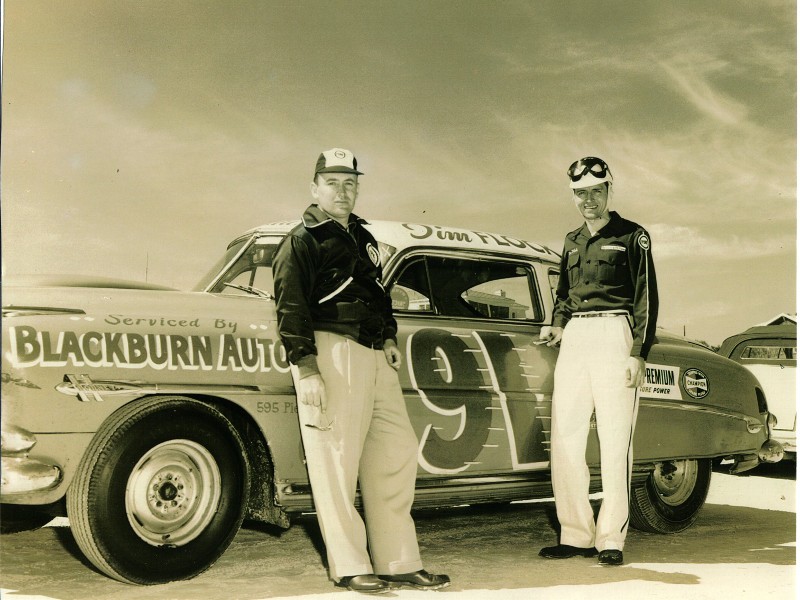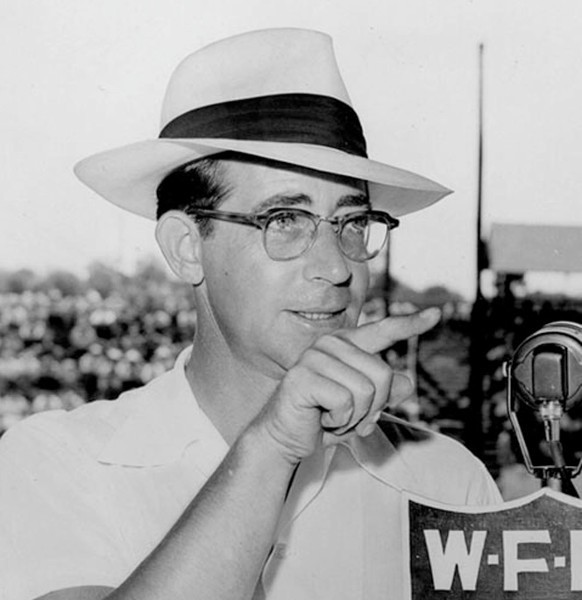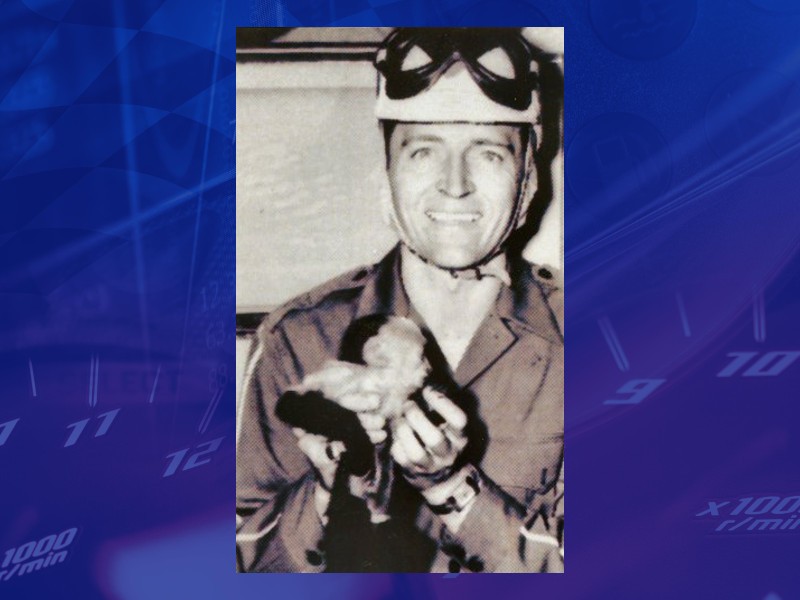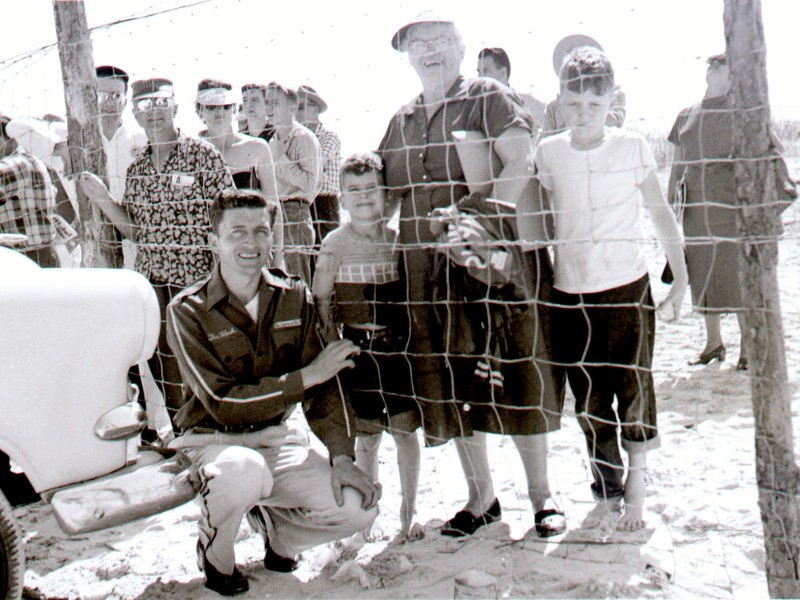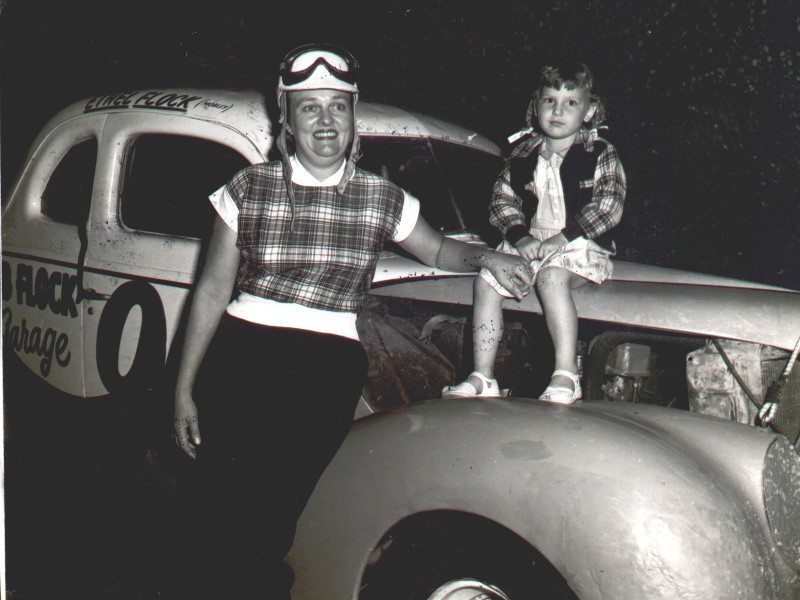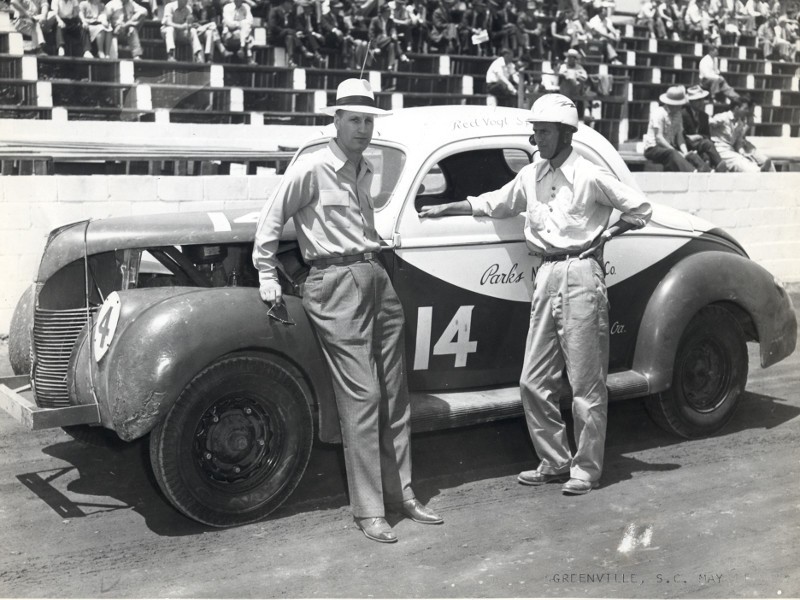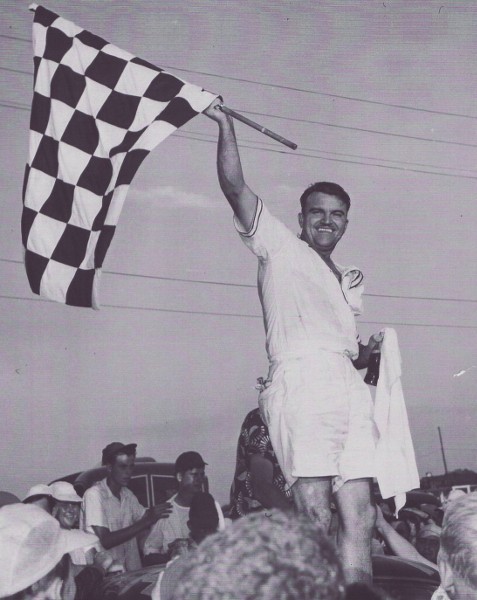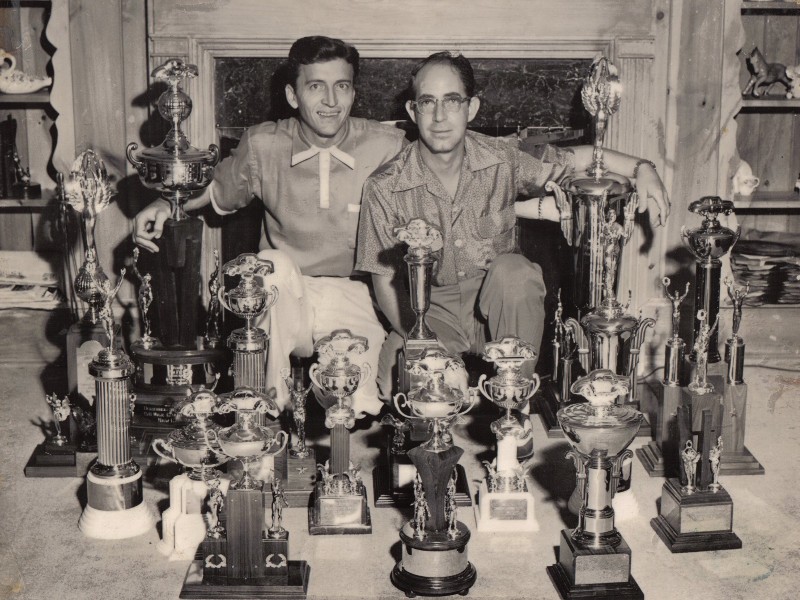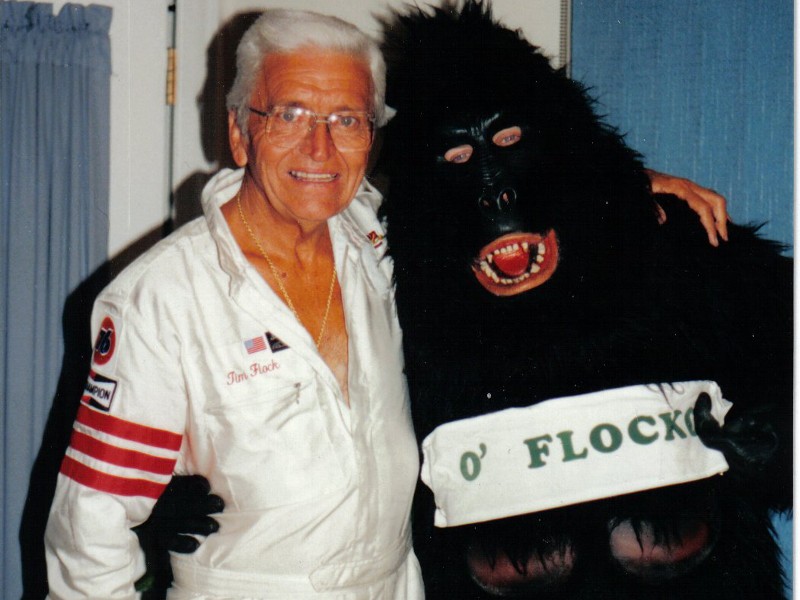During Sunday’s broadcast of the eNASCAR iRacing Pro Invitational Series race at the virtual Dover International Speedway, Fox Sports showed a shot of driver Timmy Hill driving with his cat in his lap.
Commentator Mike Joy likened this to the story of a Georgia Racing Hall of Famer and NASCAR Hall of Famer who boasts the only win with a co-driver. It’s a story that’s right out of a Hollywood script, but is firmly rooted in the truth – not to mention in the red clay of Georgia.
It’s the story of Tim Flock and his pet monkey, Jocko Flocko.
It’s fitting that the story involves the famous Flock family. The family patriarch, Lee Preston Flock – was a bicycle racer and tightrope walker. He and his wife Maudie – who would become known as “Big Mama” in racing circles – would have eight children, with half of them become NASCAR legends.
With four boys and four girls, Carl Flock was the oldest of the sons. He would go to work with his uncle, Atlanta moonshine kingpin “Peachtree” Williams, to help support the family after Lee’s death in 1925. He was also a world champion speedboat racer, winning at the Chicago World’s Fair in 1933. On a side note, Carl’s wife, Vera “Punkin” Flock, was a championship trap shooter.
One sister, Reo, was named after father Lee’s brand new automobile he had purchased just prior to her birth in 1909. Reo was an early motorcycle rider with a knack for riding while standing up in the seas. After witnessing a parachute exhibition at a small Atlanta airport, she became a parachutist and a daredevil wing walker on airplanes in flight. She would pass away from tuberculosis caught from her husband, Bill, in 1936 at the age of 27.
Another sister, Ethel (named for the gas additive) was a pioneer stock car racer who competed in NASCAR and held her own against her male counterparts. She competed at Atlanta’s treacherous Lakewood Speedway, as well as at the New Atlanta Speedway and on the sands of Daytona Beach.
The three youngest brothers – Bob, Fonty and Tim – were all racers, winners and champions in stock cars, with Bob and Fonty competing both before and after World War II. All three would score wins on the beach at Daytona, and competed for championships in the modified ranks.
Bob raced for legendary car owner Raymond Parks among others, winning at Daytona Beach, North Wilkesboro and Greenville-Pickens Speedway. Fonty was a talented racer who won the final national stock car title before NASCAR was formed.
But youngest brother Tim would was the one who went the farthest, often with his family by his side supporting and helping him.
While Bob and Fonty honed their skills by running moonshine out of Dawsonville, Georgia down into Atlanta, Tim wasn’t allowed to take that path. Big Mama had made his two older brothers promise to keep him out from behind the wheel of a whiskey running car. And you didn’t break a promise to Big Mama.
Bob and Fonty instead took Tim to Lakewood Speedway for private lessons on how to hustle a stock car around a race track. To their surprise, Tim was soon turning faster laps than his more accomplished brothers.
Tim scored his first major victory in a NASCAR Modified event at Greensboro in 1947. He won his first NASCAR Cup Series race at Charlotte Speedway in 1950.
But it was a pairing with another Georgian that gave Tim the breakthrough that would make him a Hall of Famer.
In 1951, he would begin driving for Atlanta car owner Ted Chester. Piloting the No. 91 Oldsmobile, Tim scored seven victories on the NASCAR Cup Series tour.
In 1952, the team moved to Hudson Hornets, with famed Hudson mechanic B.B. Blackburn building their racers. The team scored eight wins, 22 top fives, 25 top 10s and four poles in 33 starts, with Tim winning the first of two NASCAR Cup Series titles.
It is here that Jocko Flocko comes into the story.
Chester was in Atlanta during the early months of 1953, doing some shopping. He had stopped by a pet shop to pick up a present for someone when his eyes landed on a cage with a small Rhesus monkey inside. The name on the cage said “Jocko.”
Chester, who was also a top notch race promoter, instantly had a thought. The name “Jocko Flocko” immediately came to mind, along with a promotional idea for his race team and his driver that was second to none.
What if he had the little fellow race alongside Tim Flock in the team’s Hudson Hornet?
Without a second thought, he bought the little monkey and made a beeline for Tim’s home just outside of Atlanta.
At first, Tim thought Chester had been drinking. No way could he be serious about this crazy idea. But the more he thought about it, the more he liked it. And the legend of Jocko Flocko began.
Chester had Blackburn fix a special seat on the passenger side of the No. 91 Hudson, making sure that it was high enough so Jocko could see out the front window and that the fans could see him. He also had a special jumpsuit made for him, with Jocko’s name on the front and the car number on the back, along with a helmet for the little fellow.
The one thing he couldn’t quite figure out was how to convince the NASCAR officials that it was a good idea. So in the end, he just didn’t tell them.
The historic moment came on April 5, 1953 in a 150-lap race at the half-mile dirt Charlotte Speedway. Tim qualified on the pole, putting all eyes on the No. 91 at the start.
Just before the cars were to roll off, Blackburn and Chester smuggled Jocko into his seat and buckled him into his seat for his first career start.
Tim led 87 laps, but had a mechanical problem that slowed him with 24 laps left to go. He would soldier on to finish fourth behind winner Dick Passwater, with Georgia’s Gober Sosebee in second and Herschel Buchanan in third.
During the race, word had gotten out about Jocko, with fans clamoring to get a glimpse of the high-speed simian. Afterwards, Tim took him over the grandstands to meet his adoring public, who fed the little fellow peanuts and lavished him with attention.
Jocko Flocko was an immediate hit.
“Big Bill” France, the head of NASCAR who never was one to pass up on a promotional gimmick, had his officials simply turn a blind eye to Tim’s co-driver. He could see more ticket sales based on the attention that his defending champion and Jocko Flocko could bring to the series. By the time the tour raced again, the team had added Jocko’s name over the passenger’s side door of the race car.
In all, Jocko competed in eight events with Tim. Their next race was a home state event at Central City Speedway in Macon, Georgia, where they recorded a sixth place finish. That was followed by a fifth place finish from the pole at the fast and dangerous Langhorne Speedway in Pennsylvania. Next was a trip to Columbia, South Carolina, where they finished in second to fellow NASCAR Hall of Famer Buck Baker.
Jocko Flocko’s biggest career moment came one week later, on May 16, 1953.
With Jocko beside him, Tim put the No. 91 Hudson Hornet in the lead early on at the historic 3/8-mile Hickory Motor Speedway in North Carolina. The duo led every lap en route to the victory, giving them their first trip to Victory Lane together.
They scored a $1,000 paycheck for the win, with Jocko being paid in peanuts.
While his presence was indeed a huge hit with the fans, to say Jocko Flocko was nothing more than a gimmick would be wrong.
Tim noted that when he was racing alongside someone, the competitor would look over and see Jocko looking back at them. The shock of the sight of the little fellow would cause their opponent to break concentration for just a moment, allowing Tim to take the position away from them.
The team had some rough outings over the next few races. The day after the win at Hickory, the tour travelled to Martinsville Speedway. Tim and Jocko led the first two laps of the race, but a broken spring on lap 18 sidelined the Hudson Hornet, leaving them with a 32nd place result.
Up next was a trip to Powell Motor Speedway in Columbus, Ohio on May 24. Tim and brother Fonty checked into a nearby motel, where they each had their own room, as did Jocko.
With Tim and Fonty checking in at the track, Jocko was left on his own in his cage at the motel. The mischievous little fellow had managed to unlock his cage, and was playing in the room when a maid came by to drop off some towels.
Having no idea that the room was occupied by a small simian, she was quite shocked when Jocko jumped out of hiding in an attempt to play with her. He landed on the maid’s back, and started playing with her hair. Scared out of her wits, she ran from the room screaming and waving her arms in the air.
Upon their return, Tim and Fonty learned that they, along with Jocko, were all being evicted from the motel, and would have to sleep in their cars overnight.
The next day, a bad bearing on the Hudson ended Tim and Jocko’s race day on lap 57, credited with a 22nd place finish.
Up next was a trip back to North Carolina to the one-mile paved Raleigh Speedway. The team was hoping to share their bad luck, but instead, it ended up being the final start of Jocko Flocko’s career.
Over the closing laps, Fonty Flock had worked his way to the lead, with Tim and Jocko trailing him in second. It looked like the team was going to get their season back on track with a solid finish in the money.
In the early days of NASCAR, there was no such thing as a racing tire in Stock Car racing. The teams would use regular street tires. To monitor tire wear, a small door was cut into the right front wheel well, attached to a chain that the driver could pull. Over the course of the race, the driver could pop open the door and see how badly the tire was wearing. If the tire started to turn white, it meant it was down to the cord and a pit stop was needed.
Over the course of the previous eight races, Jocko had watched Tim pull that chain thousands of times to check the tire wear. Over the final laps of the race at Raleigh, Jocko did something he had never done before. The curious little guy unhooked his seatbelt and climbed down into the floorboard to inspect that hatch.
Jocko pulled the chain, just as he had seen Tim do, and watched the little door open up. Seconds later, the tire kicked up a small piece of gravel into the car. It didn’t hit Jocko, but it passed close enough to scare him.
Jocko started screaming at the top of his lungs, and started running around and climbing all over the inside of the Hudson. At speeds approaching 100 miles and hour, with cars all around, Jocko jumped onto Tim’s back, screaming and clawing in fear.
Tim was known by his competitors and being one of the coolest, calmest drivers in the business. He showed every bit of that in the following moments.
Tim brought the Hudson down pit road, stopping in his pit stall and handing Jocko out to the crew before heading back out on the track.
The unplanned pit stop to extract Jocko cost Tim a spot in the rundown. He would finish in third behind Fonty and second place Speedy Thompson. The extra stop cost the team some $600 in the pay out.
That marked the end of Jocko Flocko’s racing career. He would retire to Tim’s home, where he lived out his days as a pet to his children. He passed away a couple of years later, and was buried behind the garage at the family’s home outside of Atlanta.
Tim’s season didn’t go much better after Jocko’s departure. A few races later, he was injured when a car parked on top of him as he slept in the infield at Spartanburg. He would miss several races, and the Ted Chester Hudson team never won again.
Tim would rebound with one of the greatest seasons in history in 1955. Driving for Carl Kiekhaefer, Tim scored 18 wins in 39 starts, nabbing his second career NASCAR Cup Series championship. He would go on to win a total of 39 races in his Cup career before hanging up his helmet in 1961.
Tim passed away in 1998, the same year he was named as one of NASCAR’s 50 greatest drivers. He was a first year inductee into the Georgia Racing Hall of Fame in 2002, and was enshrined in the NASCAR Hall of Fame in 2014 – the first Georgian to be inducted there.
Ted Chester fielded cars in only eight more races in the late ‘50s, and did not score another win as a car owner. He would continue to promote races, including events at Lakewood Speedway, at Atlanta’s famed Peach Bowl Speedway and at Florida’s Five Flags Speedway, among others. He joined Tim in the Georgia Racing Hall of Fame in 2005. Both men now have streets named for them in downtown Dawsonville.
And what of little Jocko Flocko? There are no Hall of Fame honors for NASCAR’s only co-driver thus far, although he was featured on a commemorative t-shirt sold at the NASCAR Hall of Fame when Tim was inducted.
He was also honored with his name over the passenger’s side door of every die cast model reproduction of Tim’s 1953 Hudson Hornet. He was also honored in the 2017 Disney/Pixar film “Cars 3”, with the Mack character disguising himself as being from “Jocko Flocko’s Party Supplies.”
But Jocko’s great reward is that of being a racing legend. When his story is told on television, there are always pictures and film footage flashed up to prove the story is true. And as long as he lived, Tim never tired of telling the story of his little racing buddy.
For the rest of his life, it never failed that Tim would be at an event signing autographs and someone would ask him “Whatever happened to Jocko Flocko?”
Flock would always give them a smile and say “Well, I couldn’t teach him to sign his autograph, so I had to fire him!”




